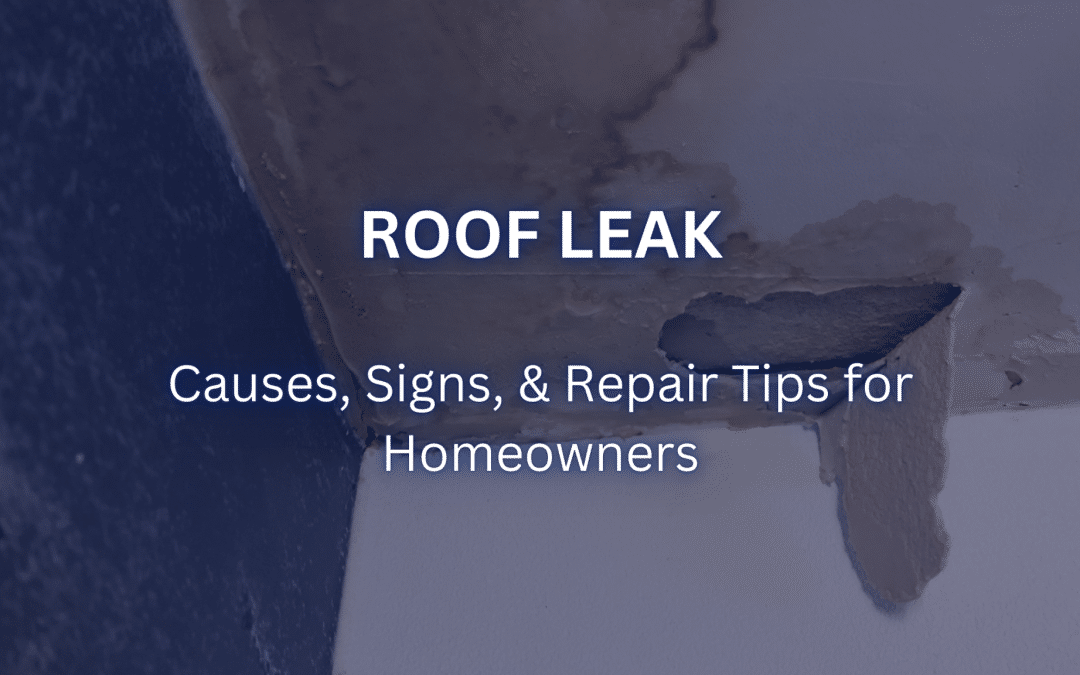Roof Leak: Causes, Early Warning Signs, and Repair Tips
A leaky roof may start small, but the roof leak causes are often hidden and destructive. What seems like a little water dripping can lead to serious water damage, mold growth, and even problems with electrical wiring inside your home.
The common roof leak often starts as a tiny hole or improperly installed component and worsens during storms, heavy rain, or snow.
The good news? By learning the most common causes of roof leaks and spotting the signs early, homeowners can take action to avoid leaks, prevent water intrusion, and protect their homes from costly damage.
Common Causes of a Roof Leak
There are many reasons a roof leak can happen. Here are the most common causes that leave asphalt shingle roofs and other systems vulnerable.
Damaged or Missing Shingles
Damaged shingles, cracks, or missing pieces are among the most common causes of a leaking roof. On asphalt shingle roofs, strong winds, hail, and storms loosen shingles, leaving vulnerable areas exposed. Once rainwater seeps past the top layer, it can rot wood, damage insulation, and spread to walls and ceilings.
Faulty or Improper Installation
A roof that isn’t installed properly is more likely to fail. Improper installation, improperly driven nails, or components installed incorrectly compromise the watertight seal.
For example, improperly installed flashing, skylights, or chimney caps allow rain to seep in. Even most asphalt shingle roofs can leak if the roof features are not sealed properly.
Flashing Issues
Flashing protects chimneys, vents, pipes, and skylights. Over time, flashing issues like cracks, rust, or loose seals let moisture seep in. Once water gets past the watertight seal, it may travel along roof valleys, beams, or attic spaces before dripping onto ceilings. These leaks are tricky since the signs often appear far from the actual hole.
Clogged Gutters and Valleys
Clogged gutters and roof valleys are another of the most common causes of roof problems. When debris builds up, rainwater can’t flow properly. The backup forces water to pool, seep under shingles, and cause more damage. Blocked drainage may also worsen flashing issues and create further damage to siding and walls.
Aging Roof Materials
Even the best materials won’t last forever. Most leaks develop when roof installation is decades old. Heat, storms, and UV rays cause shingles to crack, curl, or lose granules. Over time, roof repairs become more frequent, and maintenance becomes essential.
Early Warning Signs of a Roof Leak
Catching leaks early prevents costly damage. Here are the signs to watch for:
Interior Warning Signs:
- Water stains on ceilings or walls
- Mold growth or musty odors in the attic
- Peeling paint, bubbling drywall, or sagging insulation
- Dripping sounds during or after rain
Exterior Warning Signs:
- Missing shingles or visible cracks
- Granules collecting in gutters after storms or fall
- Flashing issues around vents, chimneys, or skylights
- Sagging valleys or roof features that look uneven
Remember, most leaks don’t stay at their entry point. Water may travel through roof valleys, beams, or wood framing before showing up on your walls or ceilings.
When Roof Leak Repairs Are Urgent
Some leaks need immediate roof repairs. Call a professional roofing contractor right away if you see:
- Active water dripping during heavy rain
- Large, spreading ceiling stains
- Sagging roof deck or drywall
- Standing water in the attic
Ignoring these can cause serious water damage, mold, and even further damage to your roof’s integrity. Even mold can develop within 24–48 hours.
Leaky Roof Repair Tips and Solutions
The next steps depend on the severity of the leak.
Short-Term Fixes (DIY):
- Place buckets under water dripping to protect belongings
- Use a tarp over vulnerable areas to avoid further damage
- Clear clogged gutters and remove debris from roof valleys
Long-Term Professional Solutions:
- Replace damaged shingles and reseal flashing
- Repair or replace chimney caps, vents, or skylight seals
- Install new underlayment where water damage has spread
- Consider a new roof if most asphalt shingle roofs parts are worn
While DIY roof repair might seem appealing, roof repairs done by a trusted roofing contractor ensure the roof properly meets code, avoids improper installation, and helps you avoid leaks in the future.
Preventing Future Roof Leaks
Preventive maintenance saves money and stress:
- Schedule yearly roof inspections to inspect for cracks, holes, or improperly installed components
- Keep gutters, valleys, and roof features clear of debris
- Trim tree branches that may fall during storms and puncture the roof
- Replace worn flashing, vents, or chimney seals before storms
- Upgrade materials on asphalt shingle roofs to withstand hail, storms, and strong winds
By addressing the common causes of roof leaks, homeowners can prevent water from entering, fix vulnerable areas before they lead to bigger issues, and protect their homes from serious water damage.
Take Action Before It’s Too Late
A roof leak won’t go away on its own. If you’ve noticed signs like damaged shingles, flashing issues, or clogged gutters, don’t wait. Early repair keeps your roof properly sealed and prevents more damage down the line.
East Mountain Roofing is here to help. Call us at (505) 264-7081 or fill out our contact page to set up an inspection. Our team will take the time to assess your roof, explain what’s going on, and recommend the best repair options.
With the right care, you can avoid costly damage, keep your home protected, and feel at ease when the next storm rolls in.



